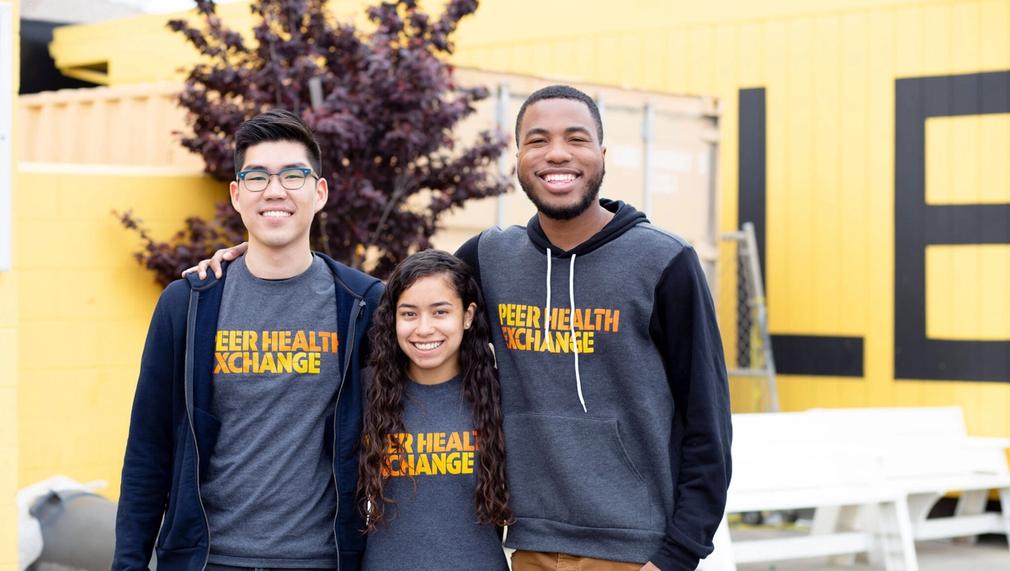Empowering LA's Youth to Make Healthy Decisions
Peer Health Exchange seeks to deliver a virtual skills-based health curriculum to students who attend under-resourced high school across Los Angeles. For the first time in our history, we are also delivering health education content directly to young people beyond the classroom, via social media platforms and our new app. With our direct-to youth work, we aim to impact young people’s health knowledge, encourage help seeking behaviors, connect young people to care, and build communities for youth centered on health topics.

In which areas of Los Angeles will you be directly working?
East LA
San Fernando Valley
South LA
County of Los Angeles
Other:: current Title 1 High School partners
What is the problem that you are seeking to address?
Now more than ever, it is critical to invest in supporting the mental and physical health of young people, in support of their overall wellbeing and academic success. Young people from marginalized communities in particular, where Peer Health Exchange (PHE) offers programs, are facing heightened social, health, and economic stressors in light of COVID-19 and widened gaps in access to care. A new survey commissioned by National 4-H Council found that 7 in 10 teens are struggling with their mental health in the wake of the pandemic. More than half of those surveyed shared that the pandemic has increased their feelings of loneliness, with 64 percent believing it will have a lasting impact on their mental health. Furthermore, • 81% of teens say mental health is a significant issue for young people in the U.S. • 55% of teens say they’ve experienced anxiety, 45% excessive stress, and 43% depression. • 70% wish their school taught them more about mental health and coping mechanisms.
Describe the project, program, or initiative that this grant will support to address the problem identified.
To meet this challenge and opportunity, PHE is investing deeply in digital tools to promote young people’s health in innovative, scalable ways. We know that accessing students through schools is important (and we will continue to provide virtual health education workshops via our high school partners), but is also limiting in terms of reach and impact. To advance equity in access to health information, skills, and resources, it is imperative that we meet young people directly on platforms and spaces that they currently use, outside the classroom. As noted, PHE is developing an app with the objective to provide a safe virtual community for young people to access and engage with reliable health information; and to be in community with one another. The app includes features such as: • Video-based storytelling on health topics, co-created by college health educators whose identities reflect the high school aged young people we serve; • Recommended health resources based on participants’ identities and health needs; • And a safe and empowering group forum for participants to foster community and engage with one another on health topics. We will promote our app through a social media campaign, leveraging our official partnership with TikTok. Also, PHE recently finalized a partnership with Crisis Text Line that will be embedded in virtual curriculum materials, social media, and the app.
In what stage of innovation is this project, program, or initiative?
Pilot or new project, program, or initiative
Approximately how many people will be impacted by this project, program, or initiative?
Direct Impact: 150
Indirect Impact: 25,000
Describe how Los Angeles County will be different if your work is successful.
Young people in LA are facing a time of massive social upheaval, increased health risks due to the pandemic, and a mental health crisis. A June 2020 study published by the Journal of the American Academy of Child & Adolescent Psychiatry found that young people are more likely to experience depression and anxiety during and after quarantine's are enforced. The result of self-isolation and removal from one’s support system means they need resources for their mental health more than ever. PHE helps fill this critical gap in the provision of effective heath education and connects students to the preventative care they need across LA. If successful, young people in LA will come away from PHE with access to critical resources, increased decision-making skills, and mental health coping mechanisms which are vital to their wellbeing. With our direct-to-youth app they will also continue to have a resource for information and connect with other young people and helpful organizations.
What evidence do you have that this project, program, or initiative is or will be successful, and how will you define and measure success?
This year, it has been especially critical to understand if our virtual health workshops are having a similar level of impact on young people as our in-person programming, and we are heavily investing in formative evaluation(what do young people like/not like about the new virtual curriculum?) in addition to our summative evaluations. To date, assessment tells us there is a broader market beyond the pandemic, and we should continue to invest in virtual options. PHE previously conducted a quasi-experimental external study with the American Institute of Research(2015 and 2016). We found PHE had statistically significant positive impact on sexual and mental health, particularly on students’ help-seeking behavior. Looking ahead, we know that as we provide more virtual solutions that we have an opportunity to encourage help-seeking behaviors, direct young people to other quality health resources, and track how they are utilizing these options for care.
Which of the LIVE metrics will you impact?
Access to mental health services